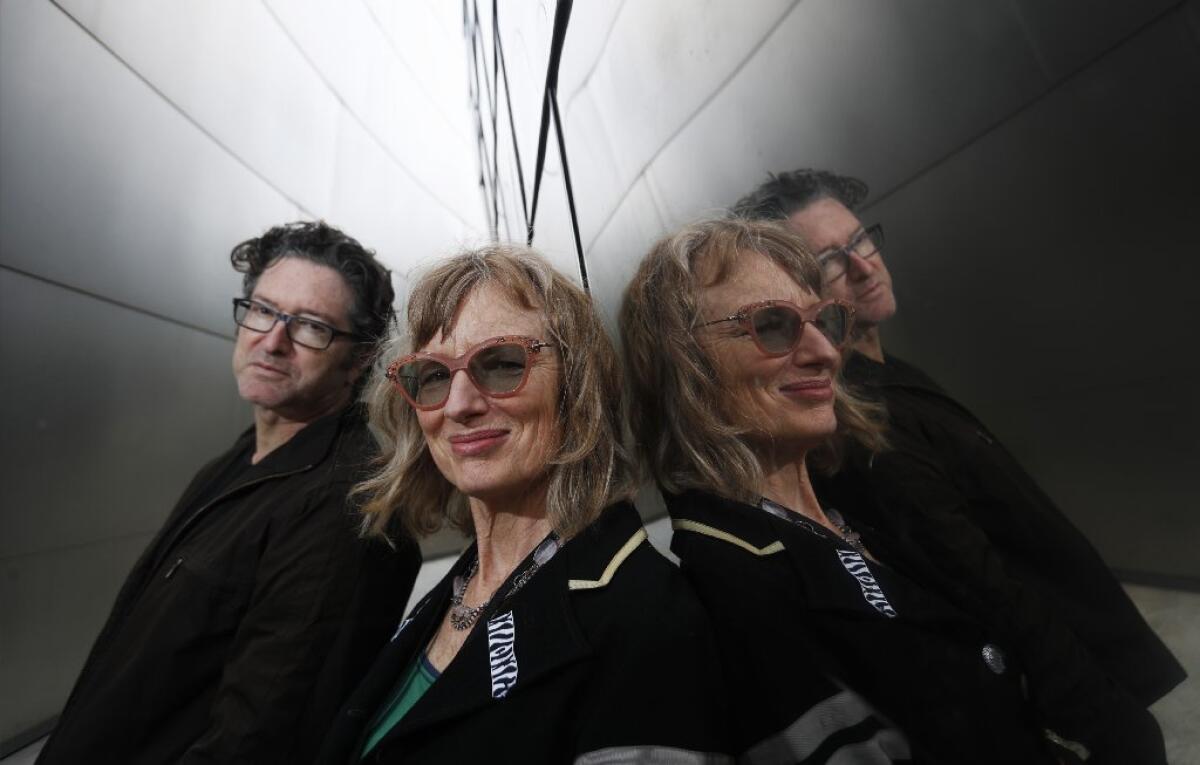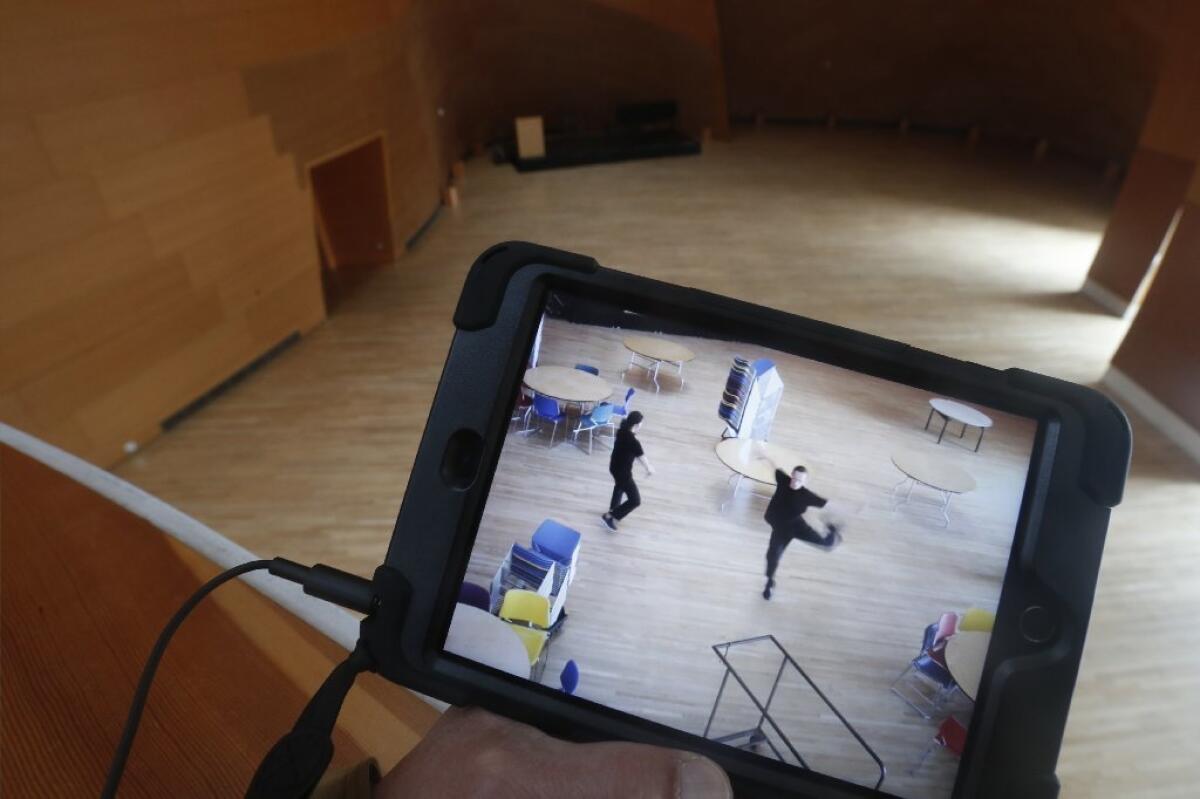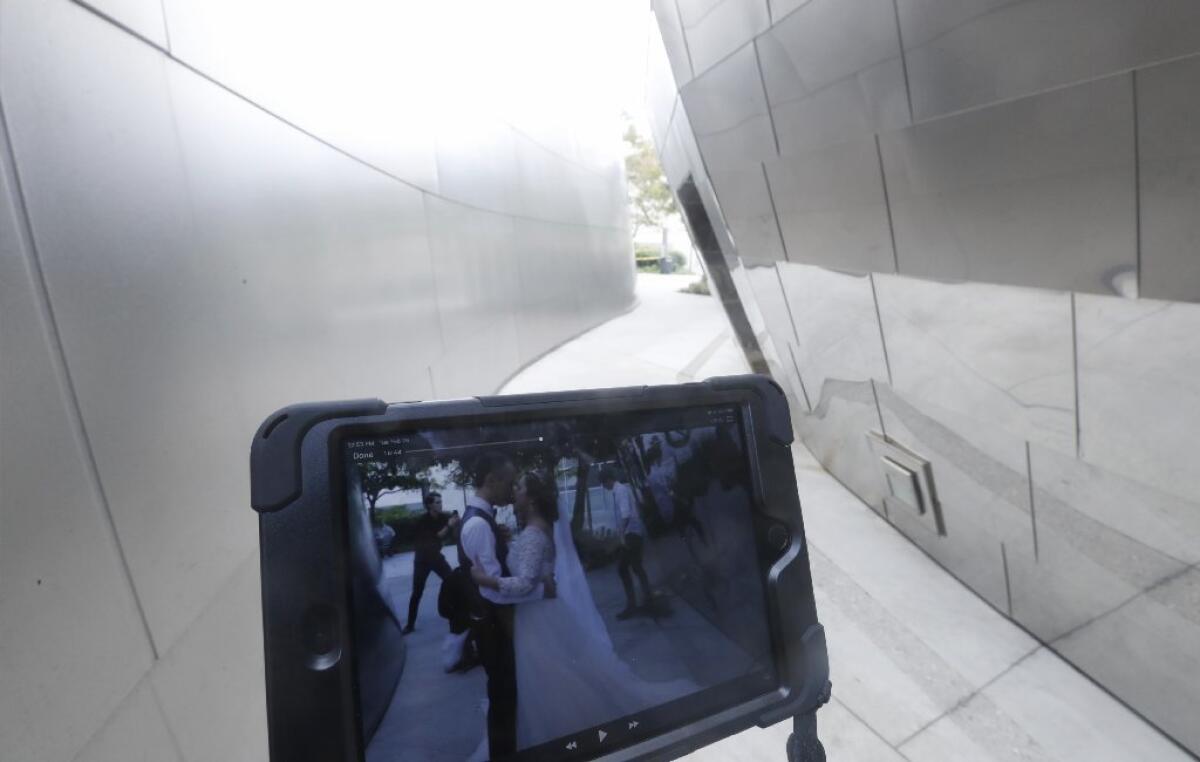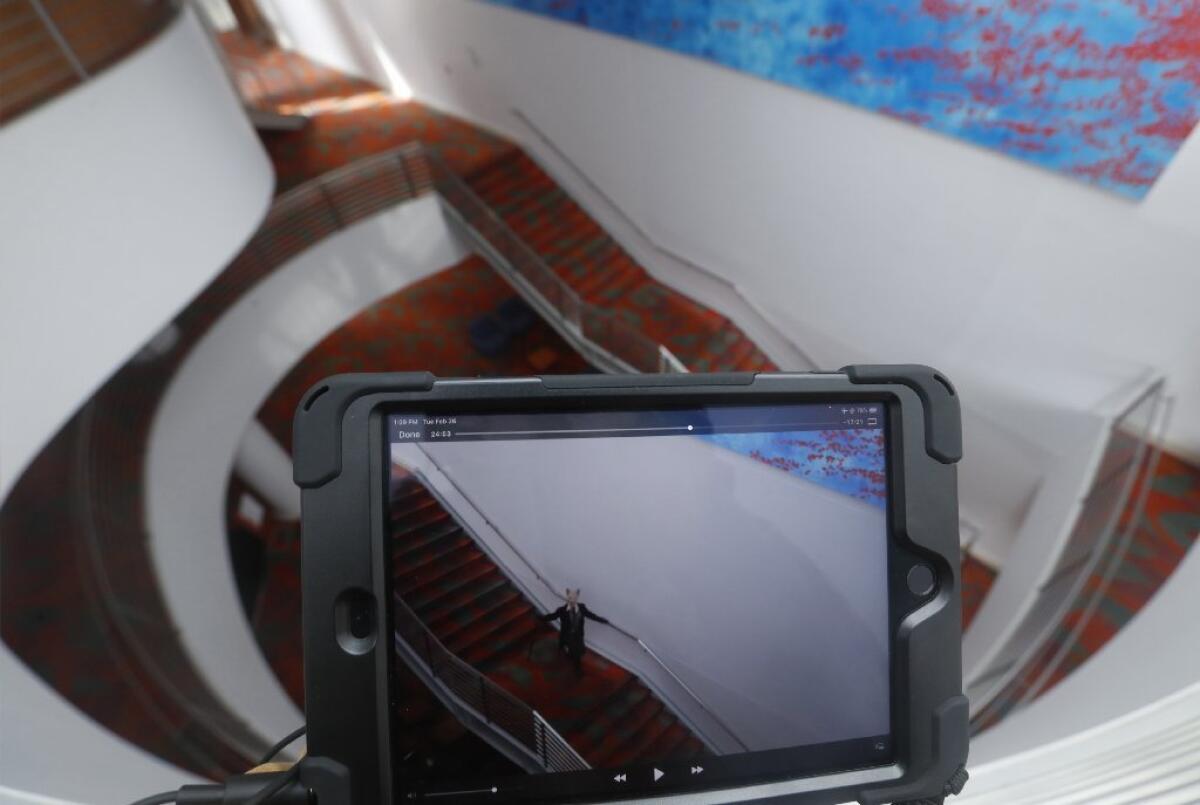Disney Hall’s ‘Thought Experiments’: New view of an L.A. landmark through immersive ‘video walk’
Meet Schroeda, a mischievous hairless cat, a little over 5 feet tall, in a purple smoking jacket with tails. She is going to lead you on a magical journey, at once dreamy and disconcerting. If you dare.
It starts in the lobby of Walt Disney Concert Hall, which is peppered with tourists today. You sit on a smooth, cool, Douglas fir bench and don puffy headphones connected to an iPad Mini. Soon, Schroeda appears onscreen, beckoning you to follow her onto the escalator, which whisks you both downward.
So begins “Thought Experiments in F# Minor,” a site-specific, immersive “video walk” installation with 3-D sound by Canadian artist duo Janet Cardiff and George Bures Miller. The 40-minute “architectural adventure” — new this spring and free to the public — is, on its most simplistic level, a tour through Disney Hall and its immediate surroundings, from the parking lot and rooftop garden to hidden staircases and little-known smoking nooks. But peel back the layers and it ripples with narrative, weaving together poetry, music, quantum physics, science fiction and news events. It’s dense with references — artistic, L.A.-specific, even personal to the filmmakers — and it sparks with philosophical and metaphysical questions, chief among them: What is real?
Which, on the tour, isn’t always so easy to ascertain.
The images you see on the iPad screen align near-perfectly with what you see in real life as you walk around: the sweeping, silvery lines of the building’s exterior through sunlit glass panes, concert-goers making eye contact with you on the escalator, bits of the hall’s orange and green patterned carpet inching closer in front of you as you reach the concert hall floor. Ambient sounds, near and far — footsteps, chatter, an opera singer rehearsing — fill your ears.
Later, onscreen, a uniformed guard smiles at you, opening a door, as the soothing, meditative voice of a narrator (Cardiff) beckons you to walk through. You look up from the iPad screen and in real life, a uniformed guard smiles at you and opens the same door. You walk through, a bit dizzied, as the lines between reality and film begin to blur.
“The video walk, it completely distorts our senses,” Cardiff says backstage at Disney Hall after a sneak peek of the tour. “I love that they question our sense of what we know about reality and how can we trust reality.”

“Thought Experiments” is one of two art commissions marking the Los Angeles Philharmonic’s centennial season. The first was a light projection by artist Refik Anadol on the exterior of Disney Hall that kicked off the centennial celebration this past September. This newest commission, celebrating the orchestra and the building itself, was initiated by L.A. Phil artist-collaborator-in-residence Yuval Sharon.
Sharon wanted to curate a project that went “beyond just performances on the stage,” he says, even more sprawling than his previous sculptural installation “Nimbus,” which debuted in 2016 above Disney Hall’s lobby escalators. He’d long wanted to work with Cardiff and Miller.
“They were on the top of my dream list,” Sharon says. “I knew they’d activate the space in the most beautiful and powerful way that would do justice to the beauty of the architecture.”
Cardiff and Miller have been making video walks — which they refer to as “physical cinema” because of how the immersive visuals and 3-D audio envelops, and affects, participants’ bodies — since 1999 all over the world, including in San Francisco, Sydney, Australia, and Kassel, Germany. That last piece was part of the international art festival Documenta 13, in which participants were led through a train station with Nazi history. But the artists had never worked in L.A. — or stepped foot inside Disney Hall. So “Thought Experiments” is infused with the fresh curiosity of someone exploring the site for the first time.
Sharon had initially imagined a site-specific piece focused only on the rooftop garden area of Disney Hall. But during Cardiff and Miller’s first tour of the premises to gather ideas, they were so inspired by Frank Gehry’s architecture that they instantly knew they wanted to go wider, meandering the entire grounds.
“A video walk is like experiencing a sculpture or experiencing a drawing or a piece of music — you have to have different textures,” Cardiff says. “You want some light, you want some shadows, a bigger space, small spaces, private spaces. You don’t always want to walk on carpet, you need some metal, some stone.”
Adds Miller: “That’s part of why we liked the hall. It has all that built in. It has all the elements of a good walk.”

The result is a lush and multi-sensory experience. You’re lured around the hall, seeing spots you might never have known existed. You’re prompted to “feel the wind on your face” outside. You smell blooming flowers in the garden. Above all, you hear a collage of sounds, recorded in binaural audio (mimicking the way humans naturally hear things, three dimensionally) that includes L.A. Phil musicians as well as originally commissioned music by Ellen Reid. At one point, we’re overlooking a seemingly “live” dance performance, choreographed by Danielle Agami, accompanied by the orchestra’s rendition of Silvestre Revueltas’ “Sensemaya.” Rounding a corner another moment, we stumble on an L.A. Phil ensemble playing in a hallway, led by assistant conductor Paolo Bortolameolli.
“Touch the wall,” the narrator coos at one point, referring to a popular meeting spot along a garden level hallway. “It looks like stone, but it’s actually made of felt.”
“People who have worked here five years have told me that they never knew that,” Cardiff says. “They think it’s granite.”
Toying with the participant’s sense of reality, turning perceptions on their heads, is one through-line in “Thought Experiments.” So too is death.
At the start of the video, we witness a heated argument in the parking lot between a woman tossing a cigarette butt out of a car window and a male passerby. After the passerby heads inside, the woman’s partner gets out of the car and follows him.
“He followed the young man into a Starbucks and punched him so hard he fell backwards, hit his head and died,” the narrator says flatly.
“That’s a true story,” Miller says. “It’s basically a re-enactment of a news story during the fire season in Canada last summer.”
Later, we glimpse texts on the narrator’s phone from a friend relaying that her cat has died and is being cremated.
“They’re real texts. My friend sent me that,” Cardiff says, again emphasizing how bits of reality commingle with fiction in the video.
The name Schroeda comes from “Schrödinger’s cat,” a paradoxical “thought experiment” by an Austrian physicist about a cat in a box and the hypothetical state of being both dead and alive. Cardiff likens it to an unsettled state of mind she observes in people “stuck” in a daunting 24-hour news cycle. “I’ve seen so many people talking and writing about ‘How do we deal with all this news all over the world that’s so terrible?’” she says. “So this idea of the cat being dead and alive at the same time, and this whole idea of boxes, is a very powerful metaphor.”

The piece is as much about intimacy and human connection through music as it is about disconnection and loneliness in a big city. At one point, the narrator even relays a story from a lonely Uber driver that Cardiff and Miller interviewed.
But the video walk also pulsates with a comforting, at times thrilling sense of connection — because touring the hall through Cardiff and Miller’s eyes and ears, you feel ever-connected not only to the space, but to the orchestra’s music and to Los Angeles, a supporting character reappearing in shots of city views. And you also feel, perhaps somewhat counterintuitively, connected with passersby onscreen, as well as real life “Thought Experiment” participants wandering past with earphones on and gazes lost in iPad screens.
“The idea interests me,” Cardiff says. “How can a video, which is an electronic medium that usually alienates you from your environment, how can that actually connect you, also, to your environment?”
At one moment, you eavesdrop on a composer, played by actress Jena Malone (who also plays the Schroeda cat) and her date. They’re discussing a Philip K. Dick story, “The Preserving Machine,” at the bar. The story is about pieces of classical music that are transformed into bugs, then back again into music — but the compositions morph in the process. In the background, we hear Bach’s “Fugue in F sharp minor” playing.
In the very next scene — because “Thought Experiments” is nothing if not referential — a morphed version of that Bach piece plays in the background; it’s a new work, “#Bang huM oFFice ruin,” composed by Reid for the project.
“Thought Experiments” will be running for five years. During that time, elements of the cityscape featured in the video will inevitably morph. When the Frank Gehry-designed complex across the street from Disney Hall is finished, for example, it will in real life block the prominent view of City Hall mirrored in Cardiff and Miller’s work.
The dissonance between reality and what’s on-screen, however, will be a happy accident, accentuating the work’s underlying themes.
“Was it ever there to begin with?” jokes Cardiff. “Like in the end, Schroeda sort of disappears. It’s this idea that maybe she was never there at all. Maybe the narrator just needed a companion when she was in Los Angeles.”
♦ ♦ ♦ ♦ ♦ ♦ ♦ ♦ ♦ ♦
‘Thought Experiments in F# Minor’
Where: Sign up in the lobby of Walt Disney Concert Hall, 111 S. Grand Ave., L.A.
When: 10 a.m.-2 p.m. most weekdays, but hours vary so check website schedule; runs through 2023
Price: Free (iPad Mini and headphones provided)
Info: laphil.com (click on “About,” then “Our Venues”)

Follow me on Twitter: @debvankin
More to Read
The biggest entertainment stories
Get our big stories about Hollywood, film, television, music, arts, culture and more right in your inbox as soon as they publish.
You may occasionally receive promotional content from the Los Angeles Times.











